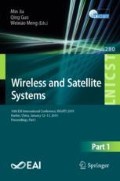Abstract
Due to the diversification of observation missions and the differentiation of satellite resources, the task scheduling of Earth observation satellites has always been an NP-hard problem. In this paper, aiming at multi-load Earth observation satellite mission scheduling, considering multi-satellite coordinated observation, facing regional target mission and point target mission, a weighted set cover model is proposed to represent the coupling relationship between multi-satellite and multi-task. The classical greedy approximation algorithm is used to optimize the sum of satellite observation time windows. The model-based algorithm can effectively save satellite storage resources and sensor resources, and realize multi-satellite coordinated observation task scheduling.
Supported by organization x.
Access this chapter
Tax calculation will be finalised at checkout
Purchases are for personal use only
References
Gabrel, V., Vanderpooten, D.: Enumeration and interactive selection of efficient paths in a multiple criteria graph for scheduling an earth observing satellite. Eur. J. Oper. Res. 139, 533–542 (2002)
Feige, U.: A threshold of ln n for approximating set cover 1 introduction. J. ACM 45(4), 314–318 (1999)
Karp, R.M.: Reducibility among combinatorial problems. In: Miller, R.E., Thatcher, J.W., Bohlinger, J.D. (eds.) Complexity of Computer Computations. The IBM Research Symposia Series, pp. 85–103. Springer, Boston (1972). https://doi.org/10.1007/978-1-4684-2001-2_9
Lin, W.C., Liao, D.Y., Liu, C.Y., Lee, Y.Y.: Daily imaging scheduling of an earth observation satellite. IEEE Trans. Syst. Man Cybern. - Part A: Syst. Hum. 35(2), 213–223 (2005)
Shamna, T.P., Praveen, P.N.: Data acquisition and delay optimization in WSN using knapsack algorithm in presence of transfaulty nodes. In: 2017 International Conference on Intelligent Computing and Control (I2C2), pp. 1–5, June 2017
Sindhu, S., Sen, G.: An optimal scheduling policy for satellite constellation deployment. In: 2017 IEEE International Conference on Industrial Engineering and Engineering Management (IEEM), pp. 100–104, December 2017
Johnson, D.S.: Approximation algorithms for combinatorial problems. J. Comput. Syst. Sci. 9, 256–278 (1974)
Chvatal, V.: A greedy heuristic for the set-covering problem. Math. Oper. Res. 4, 233–235 (1979)
Wu, G.H., Ma, M., Wang, H., Qiu, D.: Multi satellite observation scheduling based on task clustering. Acta Aeronautica et Astronautica Sinica 32, 1275–1282 (2011)
Xu, Y.L., Xu, P.D., Wang, H.L., Peng, Y.H.: Clustering of imaging reconnaissance tasks based on clique partition. Oper. Res. Manag. Sci. 19, 143–149 (2010)
Zhang, X.D., Luo, L.: Approximation algorithm for weighted set cover problem. J. Wenzhou Univ. Nat. Sci. 29(6), 46–48 (2008)
Zhu, Y., Sheng, M., Li, J., Liu, R., Liu, J.: Modelling for data acquisition, storage and transmission of EOS. In: 2017 IEEE 28th Annual International Symposium on Personal, Indoor, and Mobile Radio Communications (PIMRC), pp. 1–6, October 2017
Acknowledgments
This work is supported by the National Natural Science Foundation of China (91638202,61871456,61401326,61571351), the National Key Research and Development Program of China (2016YFB0501004), the National S & T Major Project (2015ZX03002006), the 111 Project (B08038), Natural Science Basic Research Plan in Shaanxi Province of China (2016JQ6054).
Author information
Authors and Affiliations
Corresponding author
Editor information
Editors and Affiliations
Rights and permissions
Copyright information
© 2019 ICST Institute for Computer Sciences, Social Informatics and Telecommunications Engineering
About this paper
Cite this paper
Li, P., Li, H., Chang, J. (2019). A Weighted Set Cover Model for Task Planning of Earth Observation Satellites. In: Jia, M., Guo, Q., Meng, W. (eds) Wireless and Satellite Systems. WiSATS 2019. Lecture Notes of the Institute for Computer Sciences, Social Informatics and Telecommunications Engineering, vol 280. Springer, Cham. https://doi.org/10.1007/978-3-030-19153-5_46
Download citation
DOI: https://doi.org/10.1007/978-3-030-19153-5_46
Published:
Publisher Name: Springer, Cham
Print ISBN: 978-3-030-19152-8
Online ISBN: 978-3-030-19153-5
eBook Packages: Computer ScienceComputer Science (R0)

